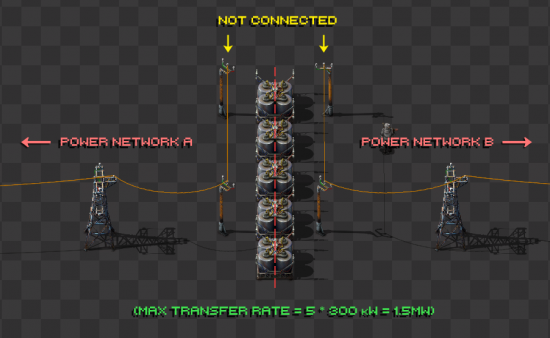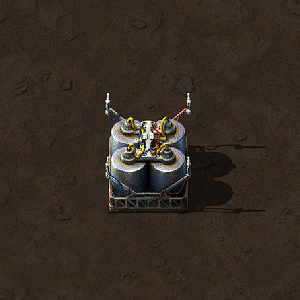Accumulator/nl: Difference between revisions
No edit summary |
|||
| Line 8: | Line 8: | ||
* 5MJ opgeslagen energy vraagt ongeveer 17s om volledig te laden of te ontladen bij een maximum van 300kW. Lees [[Time/nl]] voor verdere tijd gerelateerde berekeningen. | * 5MJ opgeslagen energy vraagt ongeveer 17s om volledig te laden of te ontladen bij een maximum van 300kW. Lees [[Time/nl]] voor verdere tijd gerelateerde berekeningen. | ||
* Er zijn 20 accumulators nodig (100MJ) om gedurende de nacht 1MW te behouden. Dit komt omdat de accumulators niet meteen bij het schemeren start met ontladen. Zie de grafiek op [https://forums.factorio.com/viewtopic.php?f=5&t=5594 this post.] | * Er zijn 20 accumulators nodig (100MJ) om gedurende de nacht 1MW te behouden. Dit komt omdat de accumulators niet meteen bij het schemeren start met ontladen. Zie de grafiek op [https://forums.factorio.com/viewtopic.php?f=5&t=5594 this post.] | ||
* Wanneer er ontladen wordt boven de maximum snelheid bij meerdere onaangesloten electriciteitspalen, de stroom wordt | * Wanneer er ontladen wordt boven de maximum snelheid bij meerdere onaangesloten electriciteitspalen, wordt de stroom wordt gelijkelijk verdeeld (Sommige krijgen 100%, anderen 0%). | ||
* May be used to provide a limited amount of power (multiples of maximum charge rate) to a section of the grid. | * May be used to provide a limited amount of power (multiples of maximum charge rate) to a section of the grid. | ||
* Produces light when charging and discharging. | * Produces light when charging and discharging. | ||
Revision as of 17:36, 6 February 2020
| Accumulator |
- Base game
- Space Age mod
|
Recept |
|||||||||||||
| ++ → | |||||||||||||
|
Totaal grondstoffen |
|||||||||||||
| ++ | |||||||||||||
|
Kleur op kaart |
|||||||||||||
|
Gezondheid |
|
||||||||||||
|
Stapelgrootte |
50 |
||||||||||||
|
50 (1 stack) |
|||||||||||||
|
Dimensies |
2×2 |
||||||||||||
|
Energiecapaciteit |
|
||||||||||||
|
Energieopname |
|
||||||||||||
|
Vermogen |
|
||||||||||||
|
Mijntijd |
0.1 |
||||||||||||
|
Prototype type |
|||||||||||||
|
Interne naam |
accumulator |
||||||||||||
|
Vereiste technologieën |
|||||||||||||
|
Geproduceerd door |
|||||||||||||
|
Verbruikt door |
|||||||||||||
De Accumulator slaat een gelimiteerde hoeveelheid energie op wanneer de productie hoger is dan de vraag. Als er meer vraag dan aanbod is, dan geeft de accumulator de energie weer terug. De accumulator kan tot aan 5MJ energie opslaan. Zijn maximum laden/ontladen capaciteit is 300kW. Indien aangesloten op het circuit network geeft de accumulator een integer signaal tussen de 0 en 100 af.
Notes
- 5MJ opgeslagen energy vraagt ongeveer 17s om volledig te laden of te ontladen bij een maximum van 300kW. Lees Time/nl voor verdere tijd gerelateerde berekeningen.
- Er zijn 20 accumulators nodig (100MJ) om gedurende de nacht 1MW te behouden. Dit komt omdat de accumulators niet meteen bij het schemeren start met ontladen. Zie de grafiek op this post.
- Wanneer er ontladen wordt boven de maximum snelheid bij meerdere onaangesloten electriciteitspalen, wordt de stroom wordt gelijkelijk verdeeld (Sommige krijgen 100%, anderen 0%).
- May be used to provide a limited amount of power (multiples of maximum charge rate) to a section of the grid.
- Produces light when charging and discharging.
- Can act as an emergency backup for the factory in case of blackout, until main power supply is restored.
- Can be used to power the base at night if it relies heavily on solar panels.
- Can act to satisfy surging demands of certain loads. If the power usage of one device exceeds production for a few seconds or so, the accumulator can provide power to the grid until said device shuts down or requires a lesser power requirement.
Other uses
Note that if throughput should not be limited, a power switch can be used instead.
Isolation of Power Networks
Accumulators can be used to isolate two separate power networks, which has a number of uses. Since accumulators have a lower delivery priority than any other entity, this guarantees that they only receive energy when you have enough left over after powering all other entities in a network. At the same time, accumulators can also be used to deliver energy in another electrical network, and can charge and discharge at the same time. Consider the following example:

The two power networks A and B are not directly connected to each other: They are connected only through the accumulators, which are shared by both networks. This is accomplished by setting up electric poles for each network connected to the accumulators, then ensuring the sets of poles are not connected to each other (which can be done by crafting a copper wire then dragging it between two connected poles to sever the connection, exactly as is done for disconnecting circuit wires).
In the above example:
- The accumulators will only charge if extra power is being produced by network A or B.
- The accumulators will discharge as needed into either network if one is not producing enough power.
- Since the maximum input/output rate of an accumulator is 300 kW, power flow between the two networks will be limited to 300 kW times the number of accumulators (1.5 MW in the example).
- Note that this isolation is bidirectional: Either network can charge the accumulators, and the accumulators can discharge into either network.
This technique can be used whenever this type of isolation is desired.
Reduction of Energy Consumption in Critical Situations
In particular, one good use for the above technique is to limit electricity consumption in low power situations by isolating non-critical parts of your factory (such as Radar, Labs, Electric furnaces, electric miners, Beacons, etc.) from critical parts (such as lasers, ammo production, or whatever your priorities are).
To do this, place your main generators and critical components on one network and place your non-critical components on another network, isolating the two as above. Now, two things will happen:
- Power will only flow to the non-critical network when you are generating a surplus on the main network, and
- The rate will always be limited to 300 kW per accumulator.
Because the accumulators will only receive power if you have a surplus on the main network, this will in effect deactivate the low-priority network when electricity is in short supply. This will also limit power consumption of the low priority network if its usage becomes high, for example if you have two factories on a low priority network and usually only one of them runs at a time, if both happen to run they won't consume more than the total limit, they'll just slow down.
Essentially you are saying "only deliver power to these systems if I have enough to spare, and even then don't exceed this delivery rate".
In general this is a technique which works well when you've just researched accumulators and solar panels, but don't have enough resources to build big solar farms and accumulator farms yet.
History
- 0.13.3:
- Reduced collision box of big electric pole to allow squeezing between it and an accumulator.
- 0.13.0:
- Now connectible to the circuit network.
- 0.12.0:
- Heavy optimisations by merging them into groups.
- 0.11.0:
- Drastically slowed crafting to 10 secs.
- 0.7.1:
- Capacity doubled, increase I/O to 300 watts.
- 0.4.1:
- Added charging animation.
- 0.4.0:
- Introduced
